
How can you turn more people in your LinkedIn network into paying coaching clients?
How can you get them to trust you as an authoritative, experienced coach?
Well, there are a few proven strategies that coaches use on LinkedIn. Here are some steps you can apply right now.
In this guide, I’m sharing 20 actionable strategies for how to get coaching clients on LinkedIn, based on some strong examples I’ve found.
Table of Contents
Write a Strong Headline
Nicole Bannon is an AI advisor and career development coach. If we check out her profile:
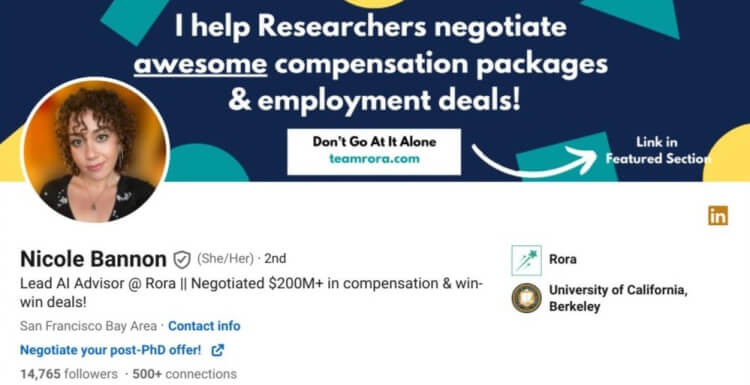
We can already see she’s doing well. What I want to focus on is her headline:

Nicole hits us with the facts up front: her job role, followed by an impressive financial negotiation. We can see this in other examples (and I’ll show you these a little later), but the key to writing a decent headline is basically this:
- State your job role.
- Follow it up with a bite-sized description of a career achievement.
This is key. People scroll through LinkedIn quickly, and you need to have an eye-catching, impressive headline to grab people up front.
Also, Nicole provides us with her contact info, which is easily available.
Key Takeaway: One thing you can do right away is pull up your headline. Does it sound confident? Coaching clients want to go for someone who knows their stuff, particularly if you’re offering career coaching, as Nicole is in this example.
Create an Eye-Catching Background Image

You’ve got to make the most of the entire space on your LinkedIn profile, the background image included. Iryna Fedchenko is a video marketing coach, specializing in YouTube marketing.
How do we know that?
Well, for one thing, she’s written it in her headline. But she’s also created a bold, eye-catching background image.
There are a few things I like about this:
- It includes exactly what she’s offering up front (YouTube marketing for businesses and brands)
- It also includes a stat to back up her knowledge and prove her success (200+ successful channels)
- It shows her face, which is helpful for getting people to trust you
- It matches her branding – the red/white continues in her profile picture, too (in fact, if you can get a professional headshot done, you really should.)
Key Takeaway: You can create an eye-catching background image on Canva without even paying for a subscription, and it’ll help make your profile stand out.
Have a Strong Voice
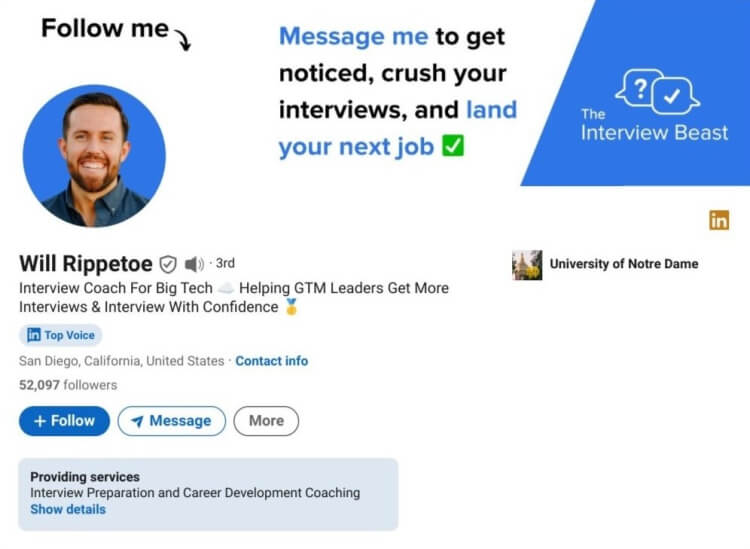
Looking at Will Rippetoe’s profile, I can spot right away that he’s doing tons of stuff right. He’s got a clear background image with a super compelling message, he’s got strong branding, and he has a good headline.
But let’s zoom in on this part:
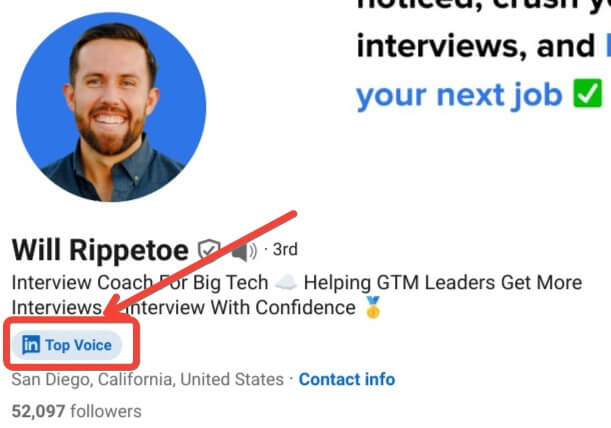
Will is a LinkedIn Top Voice. Previously known as the Influencer Program, this is LinkedIn’s invitation-only program. If you see that one of your contacts is a Top Voice, this means they’ve been contributing significant, useful info to their followers on LinkedIn.
In Will’s case, he is consistently posting short, useful snippets for his followers, who are in Big Tech.
For example, this post is strong:
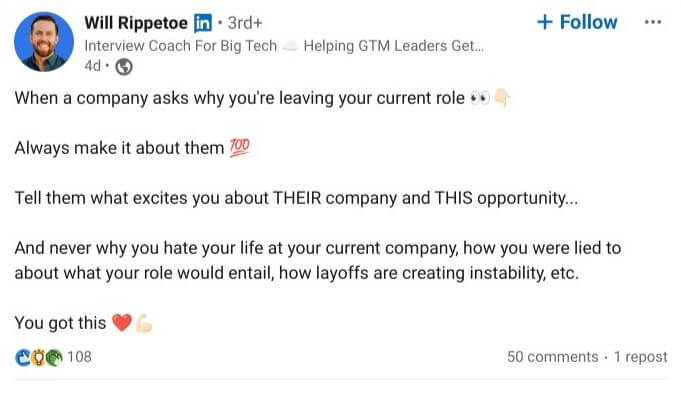
This is great. It’s short but sweet, it wouldn’t have taken Will very long to write, and it gives the reader a genuinely useful tip.
So if you want to attract coaching clients? You need to make them trust that you know what you’re talking about to your ideal audience.
You might not be ready to join the Top Voices program just yet, but you can dive into your own specialist knowledge and create a series of short-but-sweet posts giving the clients you’re targeting some specific knowledge. You don’t need to be an incredible writer, either. Just keep it friendly and to the point.
Think about what you have to offer in terms of knowledge and share it.
Use the Featured Section Wisely
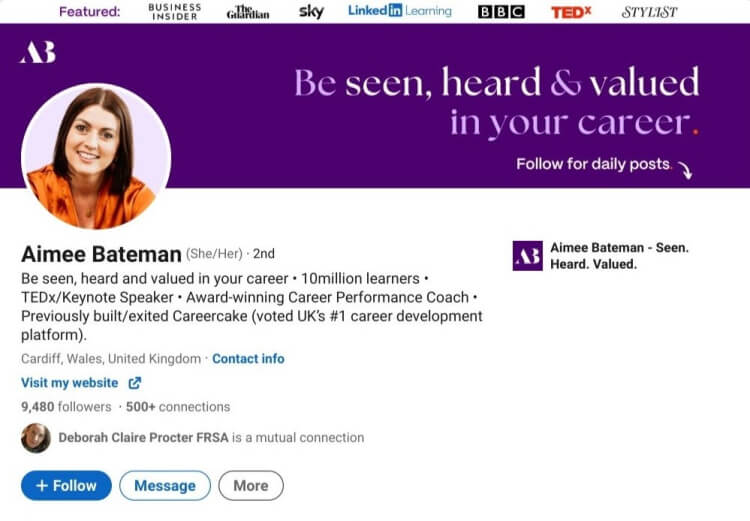
Aimee Bateman is based in Wales, UK, and her featured section is a great example of how to build trust with your ideal client.
Right away, I liked her background image, which includes Aimee’s tagline (be seen, heard, and valued in your career), which includes trustworthy organizations she has featured in, like Sky, BBC, and TedX. Her headline is strong and backed up with numbers (10 million learners).
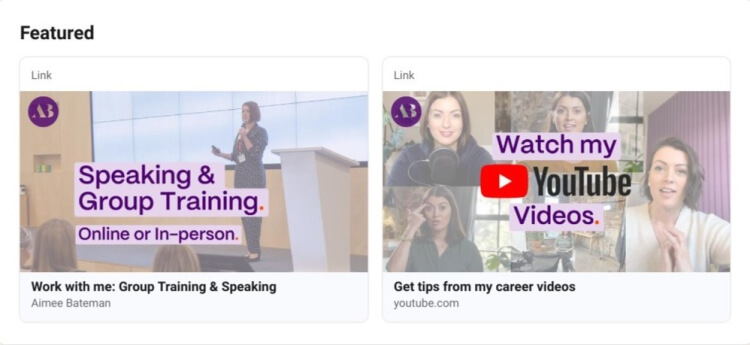
In her featured section, we see two links. The first one is ‘Work With Me: Group Training and Speaking,’ which links directly to Aimee’s services.
The second is a link to Aimee’s YouTube videos. The Featured section is your chance to both advertise your services and link people to useful content that speaks to their needs.
Key Takeaway: Think about what you want to showcase in your Featured section. Both your paid services, and anything else you have to offer, like a blog, an email newsletter, a video post, or an upcoming webinar or virtual summit.
Show Off Your Skills

Let’s check out Sharon Berman’s profile. Sharon is an executive coach, helping people with career transitions. Let’s scroll down to the Skills section:

Sharon has 50 skills listed on her profile, ranging from sales effectiveness to coaching to conflict management. Think about your own skills. What have you learned from previous jobs? What skills do you know that you can offer your own clients?
Clients will be more likely to believe what you’re saying if you can get some endorsements. Previous colleagues from former jobs and former or current clients can help you out with that, so don’t be afraid to ask.
Get Recommendations
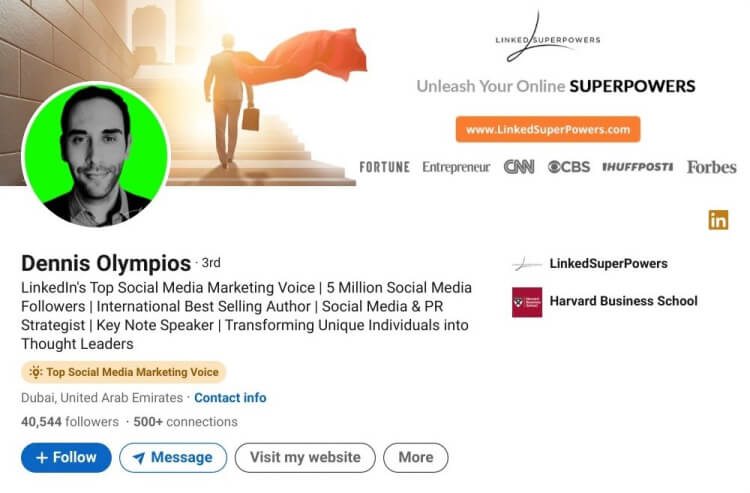
Dennis Olympios is a LinkedIn expert, so you can expect his profile to be optimized fully. Dennis doesn’t disappoint, with his reputable organization features in his background image and all the key info you want to know in his headline.
But let’s scroll down to Recommendations:
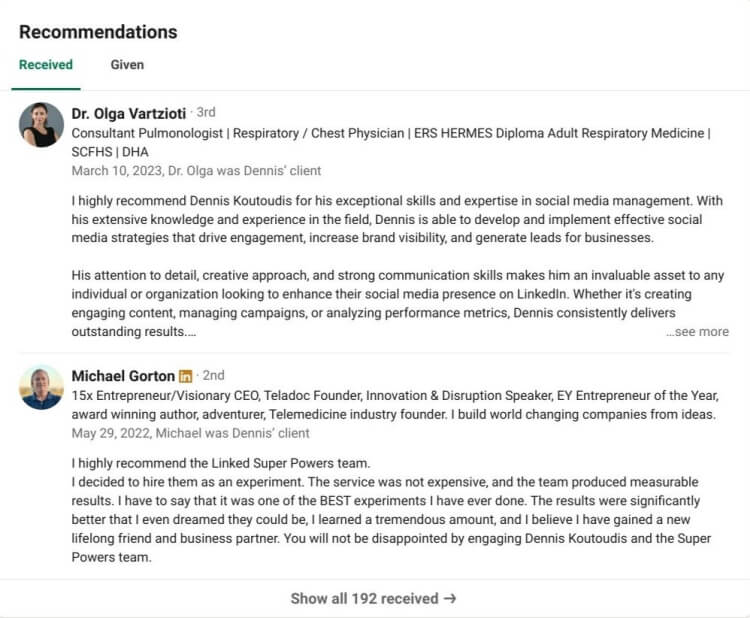
Dennis has 192 recommendations. These are detailed, useful, and praise-filled recommendations from clients. While you might be just starting out (and therefore unlikely to rack up a huge number of recommendations right away), you should get in the habit of asking every client for a recommendation.
This is a quick and easy way to build trust with future clients. If you want high-paying coaching clients, you need this. They’ll be selective, so they’ll look for recommendations to make sure you’re legit.
Post Consistently
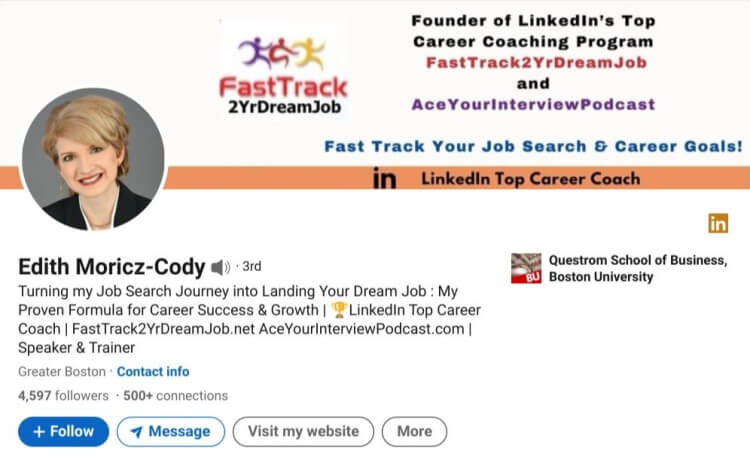
Edith Moricz-Cody is a job search coach, and she’s doing a lot of things right (as you can see from the screenshot above). Right away we can see what she’s offering.
Edith posts pretty often on LinkedIn, which is key for a good content strategy:
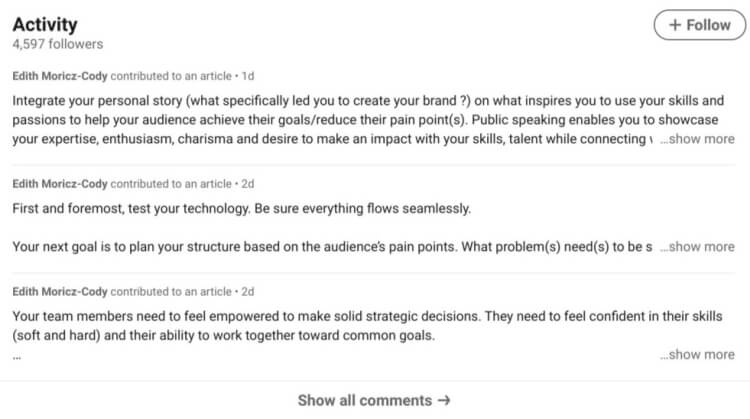
Posting valuable content consistently on LinkedIn shows your potential coaching clients that you are active, and they will be likely to hear back from you quickly if they reach out to you, thanks to your regular updates.
So whether you’re posting or just responding to other people’s posts, get into the habit of checking in with LinkedIn every day, linking to blog posts, responding to comments, and posting events. This is a good way of building your professional network.
Post Your Events
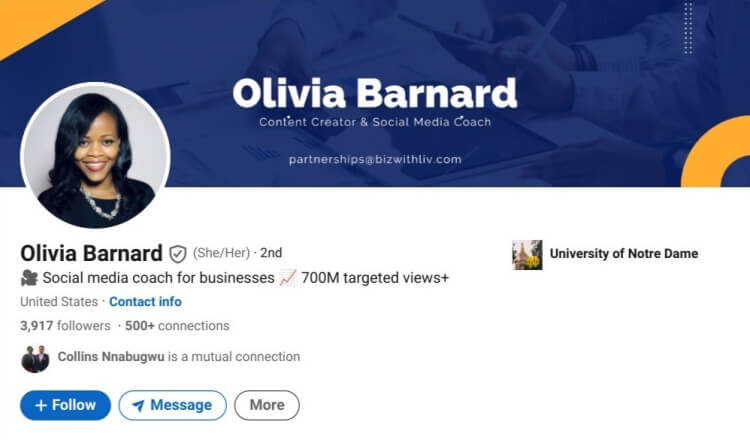
Olivia Barnard offers coaching services for businesses on social media. She has a more minimal profile, but notice that she slips in a good fact (700m targeted views+) to catch your attention.
LinkedIn is a great social platform for advertising events, so if you’re speaking at a webinar or something similar, make sure you post about it.

For example, Olivia is inviting people to see her speak at a conference. She shares the key details, and this can inspire confidence in her potential coaching clients to see her speaking at events (especially if those places or conferences have some prestige.)
Key Takeaway: If you want to attract high-paying coaching clients, look at speaking at other people’s virtual summits or in-person conferences or host your own virtual workshop or virtual summit. This is a great way to build trust in your expertise.
(And you can read more about why we love virtual workshops in our Virtual Workshop Mastery guide)
Write a Good About Section
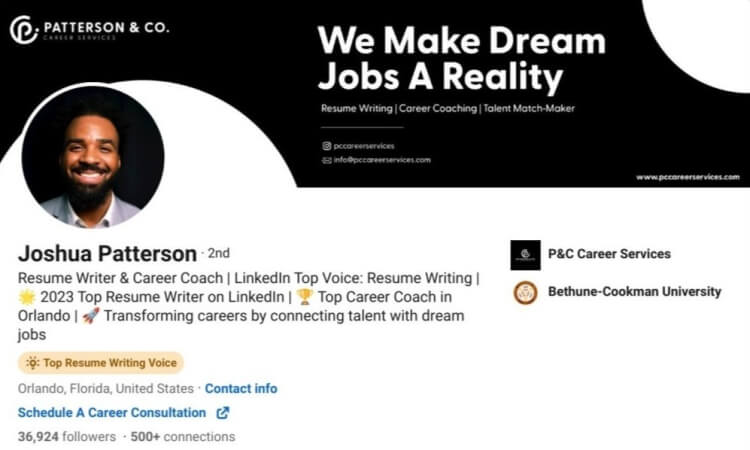
Joshua Patterson is a writer and career coach. He’s in the LinkedIn Top Voice program, and you can see that he has the accolade of Top Resume Writing Voice: these are the details that high-paying clients are looking for.
I want to show you Joshua’s ‘About’ section:
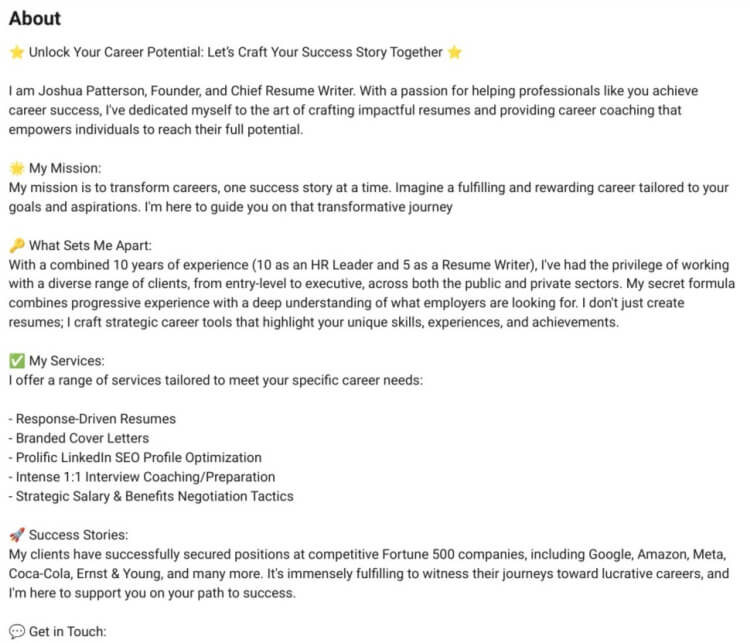
Notice that Joshua focuses everything in his ‘About’ section on what he can offer the client. Every subsection gives the reader both information about Josh and some details on what they can expect to get from his services.
If you’re struggling to attract clients, it might be time to update the ‘About’ section in your profile. Rewrite it and make sure you bring it all back to what you, specifically, can offer your clients.
You can also slip in a testimonial here from a client. If you’ll let me use a real example of mine:
“Working with Liam allowed me to grow my email list by 5,000 people, to generate $1,000s, and pivot to a completely new niche in just a few short weeks.”
That’s kind of a brag on my part, but also, this is a brilliant testimonial that is perfect for putting in an About section to establish trust.
Create Downloadable Resources
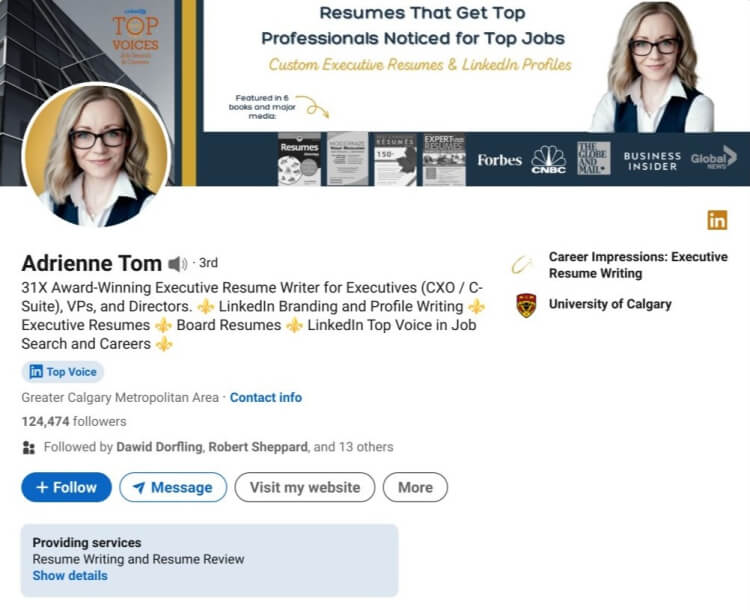
Adrienne Tom has (at the time of writing) 124k followers. That’s a huge number of followers, and it can be hard to get there when you’re first starting out. But the more followers you have, the more credibility it can give you.
One way to get more followers is to offer high-value content on LinkedIn. For example, Adrienne creates useful content like this:

Adrienne’s followers know that, by following her, they’ll receive content that will be of practical use to them. You can easily create downloadable content in your area of expertise just by hopping onto Canva. It’s worth building up a following on LinkedIn, and creating a lead magnet is a good way to attract new followers.
Show Your Humanity
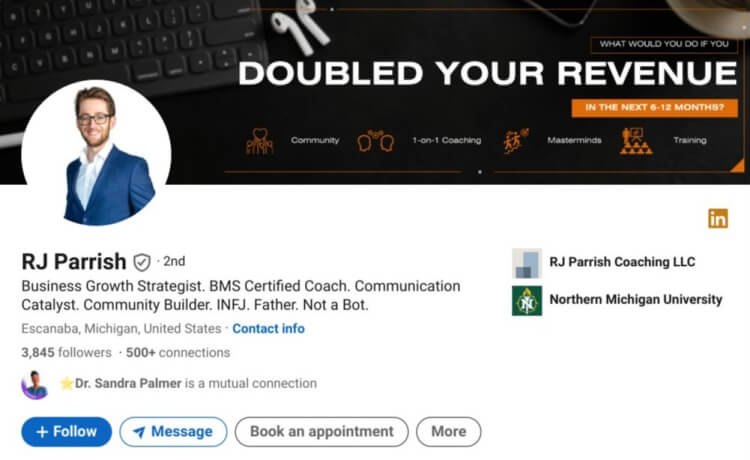
RJ Parrish is a business growth strategist. I like his headline; not only does he give you his certifications, but he also shows his human side (INFJ, father, not a bot).
People want to connect with real coaches they can relate to, and giving these small glimpses of your personality can make clients warm to you while still keeping things professional.
RJ did a great introductory post for new followers:
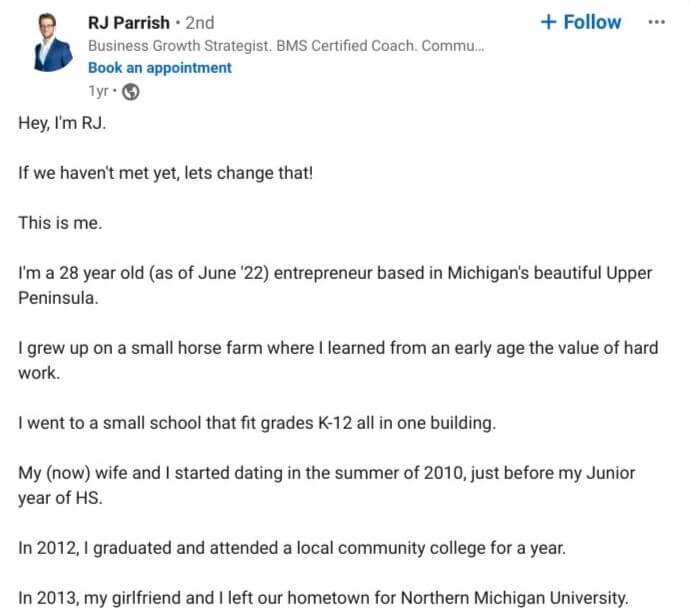
This is a nice way for people to get to know you and to trust that you’re real, rather than a bot, hopefully turning your connections into clients.
Have a memorable Personality
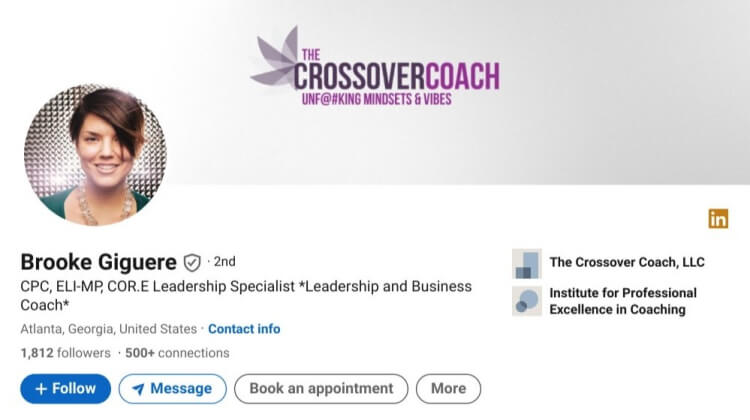
Speaking and writing, as a human, is important, but you also need to be memorable. High-paying clients are discerning and won’t interact with an account that sounds like a bot. I like Brook Giguere’s example here: her tagline is funny and interesting and will attract clients who have a similar mindset.
Brooke’s social media posts are also full of character:

Don’t be afraid to use a little humor sometimes if your client base is receptive to it.
Lead By Example

I really like Lacey Abbacchi’s profile because she has consistent branding. As a personal branding strategist, it’s really important that people can see that Lacey can manage her own brand effectively.
I also like Lacey’s profile because it has a consistent tone in her writing and a consistent color palette. It has a ‘vibe’ that is identifiable and will inspire faith in her clients that she knows her stuff.
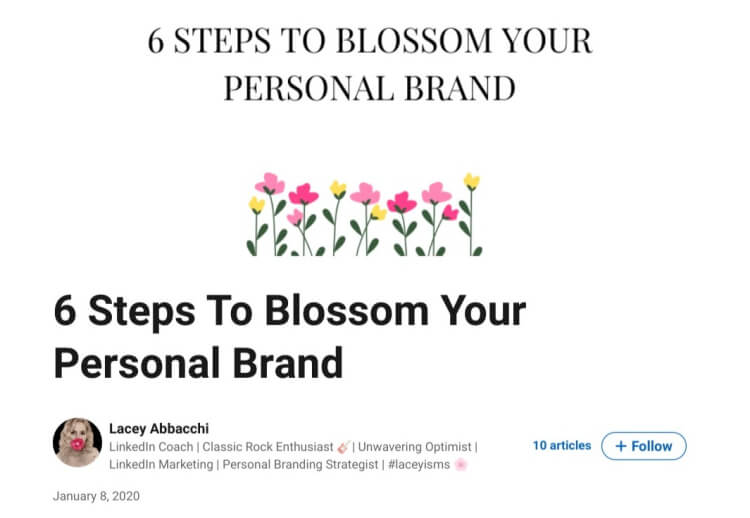
Even Lacey’s LinkedIn newsletter links to her personal branding.
Key Takeaway: Take a minute to check out your own profile: what’s your branding like? Are you showcasing your own skills? If you offer resume writing, for example, what are your own writing skills like, and how are you showing them off on your profile?
Join Groups
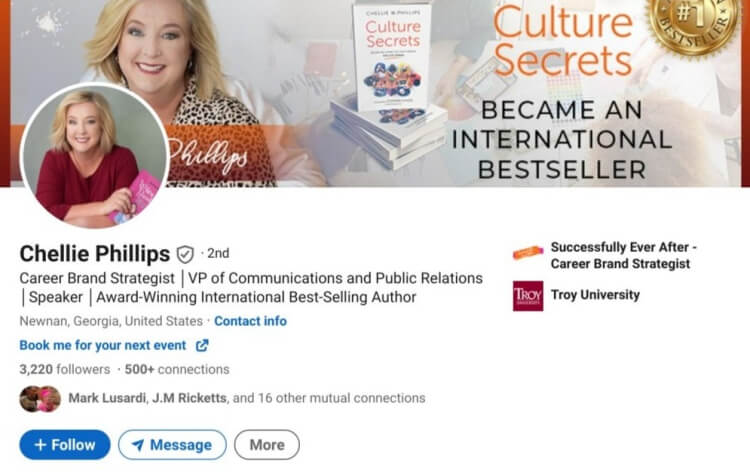
What I wanted to talk about here is the power of groups. Chellie Phillips’ groups are here:
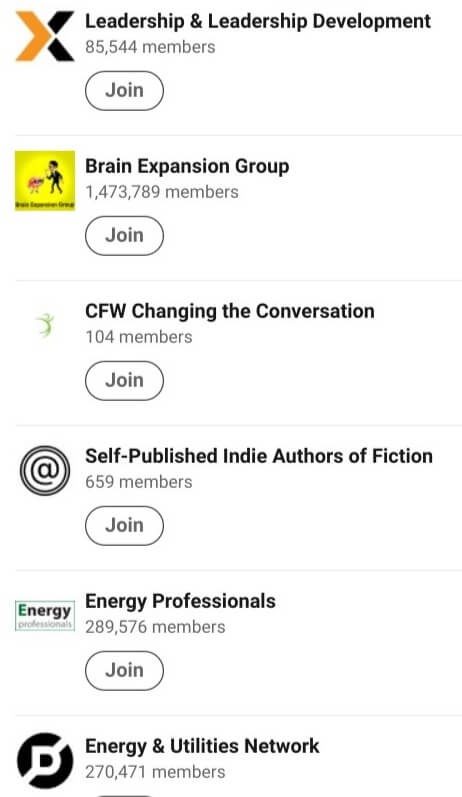
Joining groups is a great way to network with people looking for your services. After all, LinkedIn is a social network: you need to meet people to grow.
For example, if you’re a coach wanting to help people grow their social media platforms, you need to be joining groups that would appeal to those clients. Look for groups using certain keywords. If you search for YouTube, it’ll pop up with groups designed for creators.
This can help to connect you with clients who are looking for help in specific areas.
Be Specific
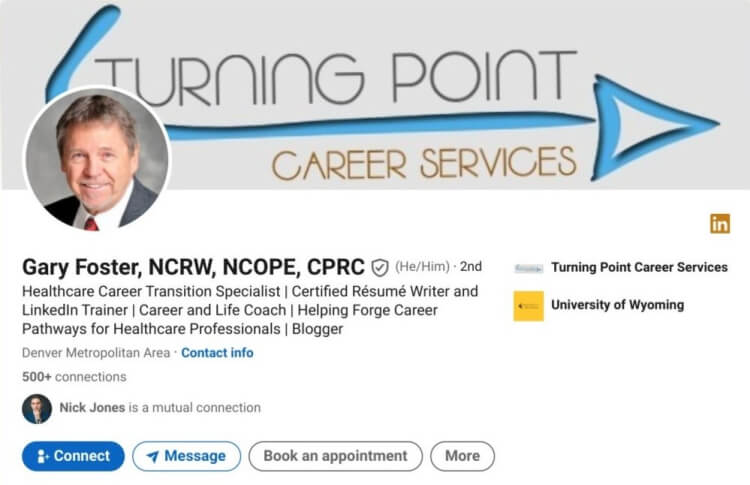
Gary Foster has a specific profile using key phrases in his headline. He’s a healthcare career transition specialist. He also mentions healthcare later in the headline (helping forge career pathways for healthcare professionals), which clearly communicates what his coaching company is all about.
Gary’s coaching niche is on display throughout his profile:

Key Takeaway: Make sure to display your specific knowledge within your niche. That way, clients will feel safe knowing that you understand the industry they work in. And that helps when it comes to optimizing your profile to rank on search, too.
Share Your Story
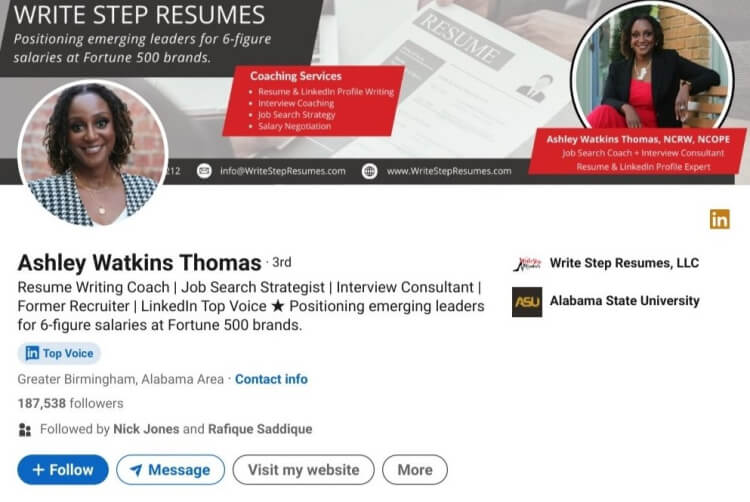
Ashley Watkins Thomas has everything I want to see in a LinkedIn profile (a strong background image, a good headline, and she’s part of the LinkedIn Top Voice program).
But I want to scroll down a little and point to this:

If you’ve got a great personal story, share it to advertise your coaching practice. If you’re a financial coach and you used to be broke, talk about it. People love a transformation story, and having that personal experience inspires trust in your clients, especially if you’ve got a big success story to tell.
Play to Your Strengths
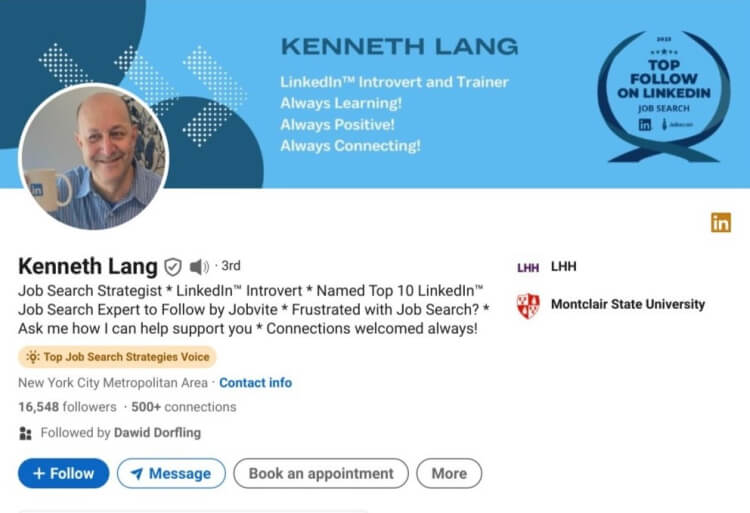
For instance, Kenneth Lang specifically highlights his introversion. This is a really good way to get clients to connect with you. I’ve also seen some strong profiles for coaches offering specific help for clients with different personality traits.
Picking a coach is a personal deal. Your ideal coaching clients want to feel that they’re going to click with you, and they’ll read your profile to get an idea of who you are and to build a genuine connection with you.

So if you’re super extroverted and fun, show it and attract those clients. If you’re quiet and introspective but detail-oriented, show that too. Again, clients of all budgets want to connect with real humans that are on their level.
Give Recommendations
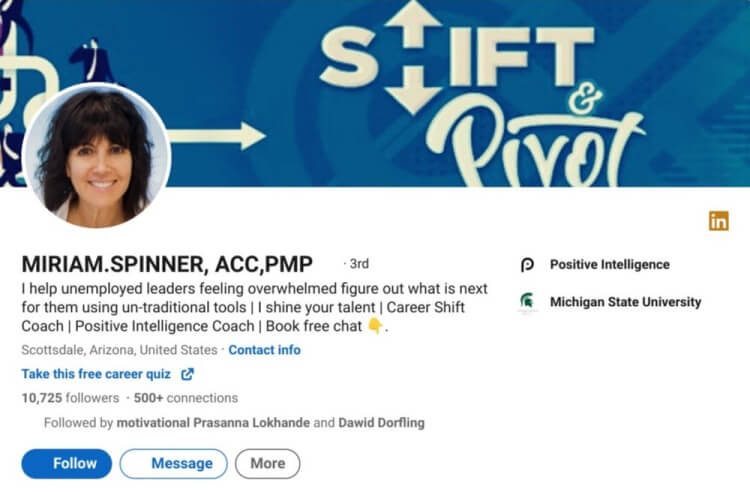
Miriam Spinner is a coach helping unemployed leaders figure out their next steps. She has a lot of recommendations, but you can see that she also provides recommendations for others:
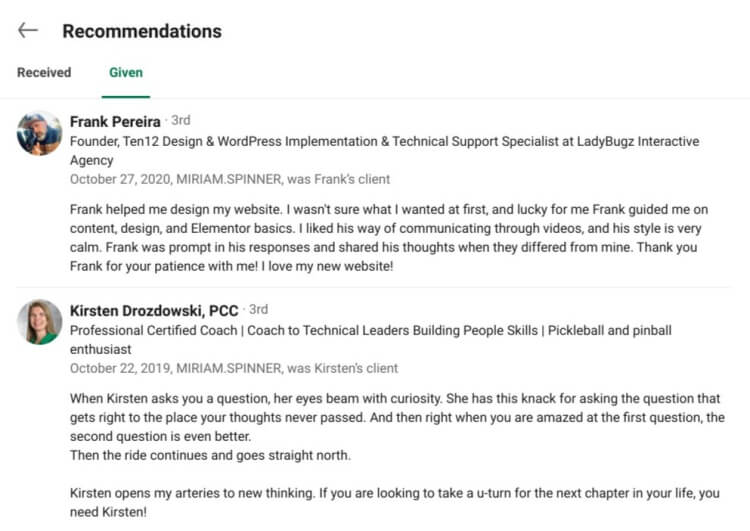
Giving recommendations is important for growing your network. If you give recommendations, the other person may reciprocate. And the more recommendations you have, the better.
Plus, people may find you via other people’s recommendations – getting your name out there will help to build your following. This is a solid part of a strategic growth strategy for LinkedIn.
Create Targeted High-Value Content
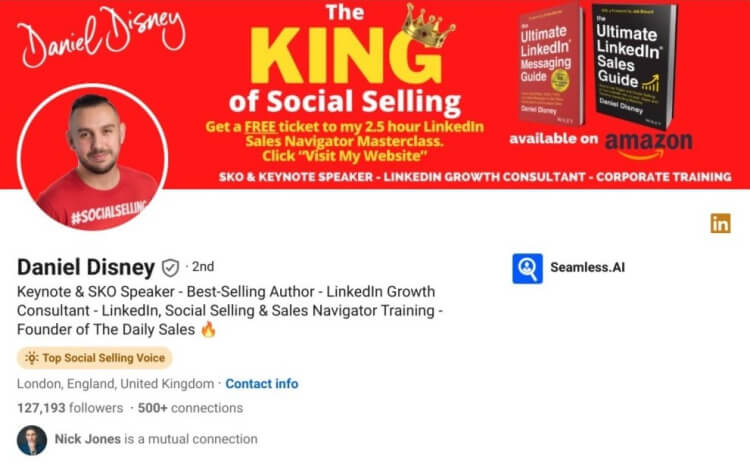
Daniel Disney creates valuable content that is specifically aimed at a certain group of people:
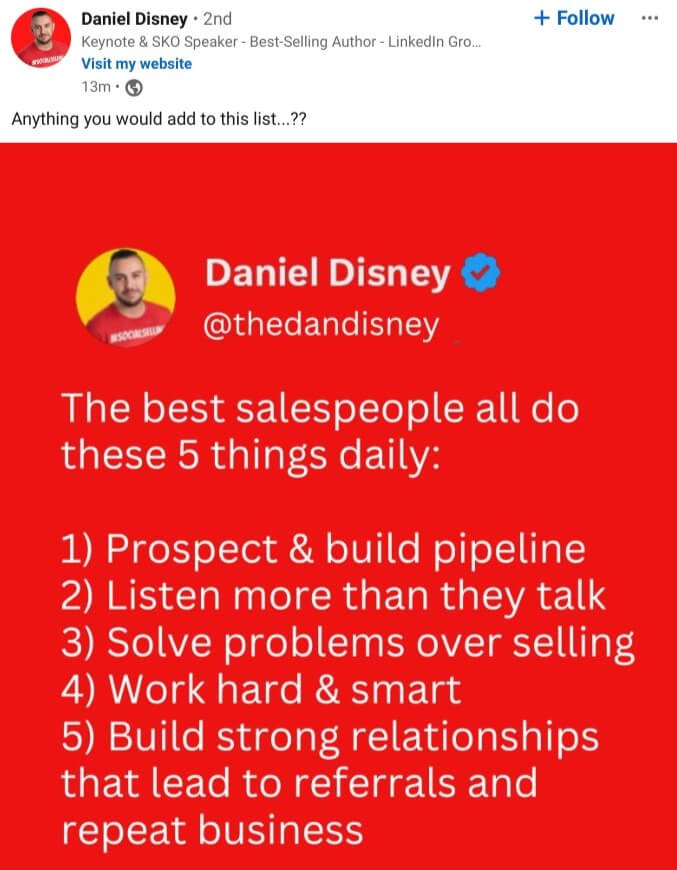
You can see here that he’s targeting salespeople. His content is thoughtful and intelligent; his clients are likely to be ambitious people working in sales wanting to land bigger contracts and clients.
Key Takeaway: Make content that attracts the kind of clients you want. You want high-paying clients to grow a 6-figure coaching business? Create content that speaks specifically to them, and they’ll know that they can trust your knowledge.
Present the Problem (and the Solution)
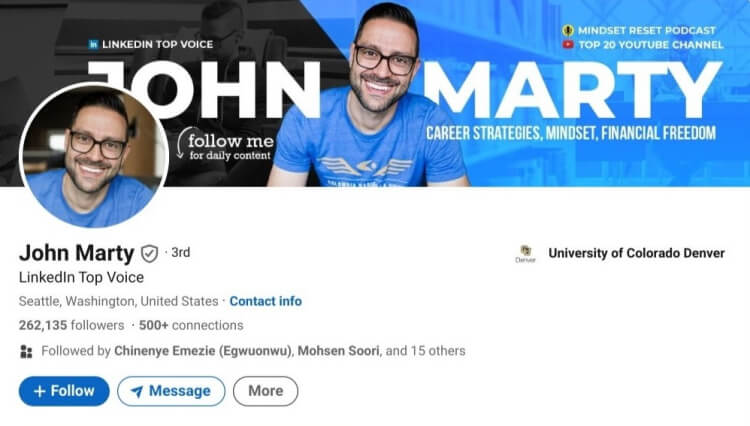
John Marty is a positive, upbeat career strategist with a strong presence on LinkedIn. His profile is sending a clear message about the kind of people he wants to connect with, and this is backed up by his about section:
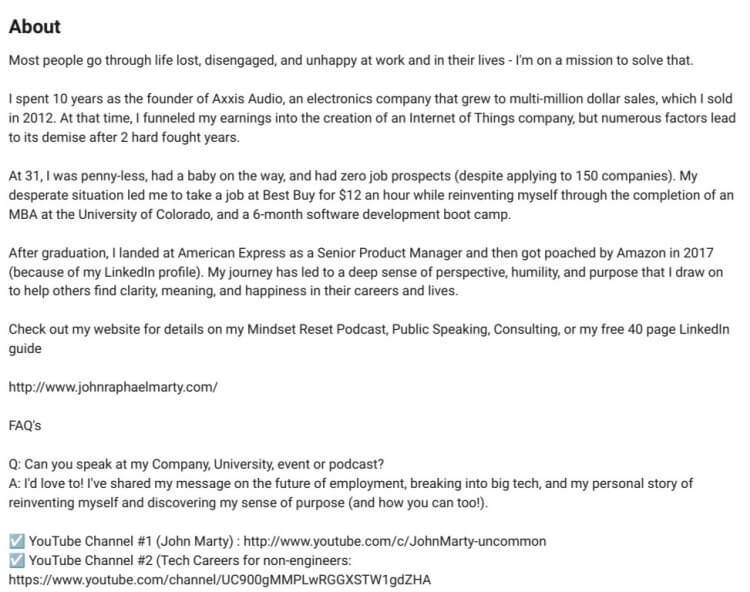
See that first sentence? ‘Most people go through life lost …’ That’s a powerful statement to make, and his story and services offer a solution to that problem using your coaching business.
Think about the problems you are trying to solve and put that upfront in your About section. Then you can tell your potential clients exactly how you’re going to solve them.
You can also post resources to help; for example, if you’re running a workshop targeted at a specific problem, then you can bring it up in your About section. I’ve personally sold over 1,000 sold over workshops myself, so I’m pretty passionate about them, and LinkedIn is the best place to advertise them.
Key Takeaways
There’s so much to be gained from LinkedIn, so it’s worth the effort. You never know when you’ll land the next client for your coaching programs.
Want to know more on how to get coaching clients on LinkedIn? We’ll be sharing wisdom from over 30 expert speakers on how they’ve seen real success on LinkedIn, so make sure to watch our free training on how to get coaching clients.
